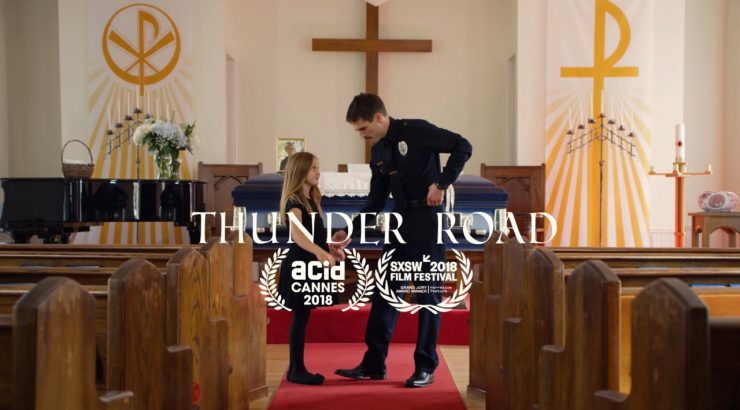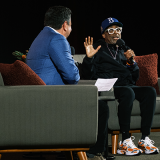The Short to Feature Lab Curriculum – Presented by Jim Cummings A Field Guide to Making Movies in 2018
November 29, 2018
No one is going to help you. You will have to do it yourself.
These are the opening words of the manifesto written by Jim Cummings. If anyone knows those words to be true, it is certainly him. Cummings is the writer, director, and star of the film THUNDER ROAD. A small film that started out as a short that he then turned into a feature. If you aren’t familiar with it, check out our October blog post about how that process happened. After winning awards from some of the biggest festivals in the country, (i.e. Sundance and SXSW) he didn’t recieve any distribution offers that worked for him. Instead of selling the rights to his film to get a deal done, Cummings decided to distribute the film himself. He is actively working to change the way the film game is played, and he is succeeding. The democratization of filmmaking has arrived, and Cummings seems to be leading the charge. As he states in his manifesto, we are the Backyard Pixar Revolution. We are coming for you.
The aim of the Short to Feature Lab Curriculum is to encourage filmmakers that a career as a filmmaker is possible. You no longer have to play by the old rules, the new ones are being written each day. Grab a camera, your friends, pick a weekend and go out and make the best possible movie you can make right at this moment. The curriculum presents a lot of advice and tips for filmmakers by someone who is out there doing it. Take a look at part 1 of the 9 part curriculum.

1. Manifesto
No one is going to help you. You will have to do it yourself.
The industry of filmmaking is changing so quickly towards producing content that everyone, even brands are becoming media creators. All of them understand the power of owning content, the modern War for attention, and all of them are years behind you as an actual filmmaker.
By gathering your friends, family, and talented, enthusiastic people you can shoot a feature film in 10–14 days, or a short film in 1. Technological advances have enabled consumers to perform the entirety of a studio’s production and post-production inexpensively. The Democratization of Feature film distribution has resulted in a vacuum of predatory buying practices which won’t keep filmmakers above the poverty line. Now, anyone can pay to get their film onto iTunes and pitched to Netflix through inexpensive aggregators like Quiver. Paired with a genuine and long-lasting care for the films, filmmakers like us can impersonate and outperform small to mid-range distribution companies. Facebook advertising has become so comprehensive that anyone with a little creative thinking and a Facebook page can find their film’s exact audience while maintaining all of their ownership and income in perpetuity. I will never understand why filmmakers give up every percent of their films’ rights, and all of their income, to people who don’t actually care about their movie.
This is not the future, it’s the present. We are living in a moment where seizing the means of production can translate into a long and industrious career for yourself in film.
People will attempt to convince you of otherwise, they will say you need to work inside of their company or their system to qualify as a real filmmaker or to be taken seriously. They do this because if you work inside of their system, you are their subordinate and they won’t have to worry about you as their competition. Let’s be perfectly clear: You are their competition. By pushing the boundaries in ways that they cannot as a company or studio, you will win their audiences every time.
The current Hollywood systems, alongside a political-generational shift towards sanitized filmmaking, has created a chasm in the market for films that use the full breadth of the 1st Amendment showing realistic profanity, realistic violence, realistic sex, realistic characters, and therefor realistic humanity, which is all that audiences connect to. Companies like A24 and Neon have made millions and won Oscars scratching this itch amongst adults, and it is so crucial for us to join in. Only we, as independents, can hurdle these uncool people to become the direct competition to their craftless and forgettable films.
We are the Backyard Pixar Revolution. We are coming for you.
A 90-year-old man walks into confession. He says, “Forgive me Father, I’ve sinned. I slept with two 20-year-old women last night outside of wedlock.” The father says, “That’s terrible, my son. When was the last time you made confession?” He says, “I’ve never made confession before father, I’m Jewish.” The Father says, “You’re Jewish? Well what are you telling me for?” He says, “Well, Father, I’m tellin’ everybody…”
There is little difference between oral storytelling and cinematic storytelling; both are equations of dramatic and comedic set-ups and payoffs. A film should be equally compelling when told aloud. I record all of my screenplays as podcasts and mix them to music and sound design; I feel it is always better display of what the film will be. Performing it out loud forces you to think hard about each moment; how can we make this stronger, what is the best version of this scene, how can we best use this moment to conduct our audience’s emotions at this point of the story? By focusing entirely on audience engagement, imagining that you are the conductor of the rollercoaster at each moment, you are already ahead of most.

To continue reading check out the full curriculum.


